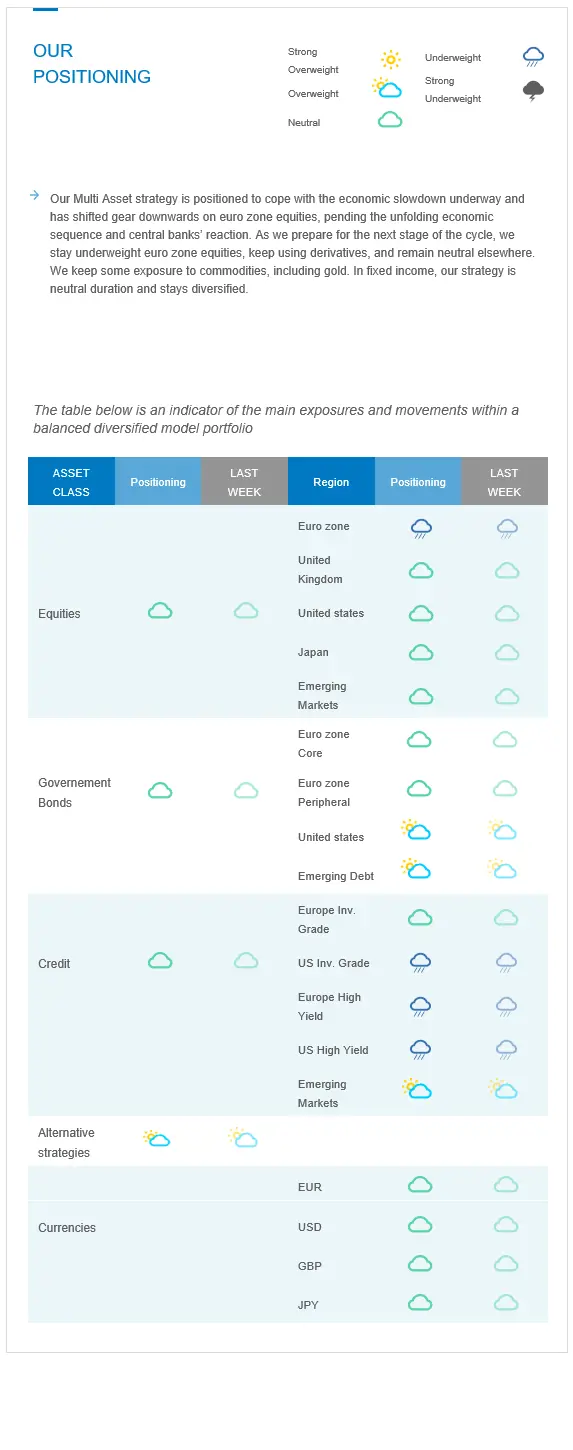Last week in a nutshell
- The US retail sales for July revealed more-than-expected spending outside auto purchases and gasoline. As it is a nominal series, a big part of the advance was however due to rising consumer prices. Industrial output rose 0.6% last month after being unchanged in June.
- Several Fed speakers and the minutes of the previous FOMC mentioned that the Federal Reserve was eager to continue tightening its monetary policy stance, albeit at a slower pace than in previous months. US inflation would have to move markedly lower before pivoting.
- The US homebuilder sentiment for the month of August fell below breakeven level. With an eighth-straight month decline, this marks the worst stretch since the housing market collapsed in 2007. Higher borrowing costs and elevated prices also pushed housing starts and building permits further down.
- The release of the ZEW expectations gauge showed a further decline in investor confidence due to the squeeze in energy prices. The pessimism regarding the German economy is now at a similar level than during the euro zone debt crisis in 2011.
What’s next?
- This year’s Jackson Hole Symposium comes at a critical juncture for monetary policy as inflation is at a four-decade high and the Fed is implementing the sharpest tightening since the Paul Volcker’s era. Investors will pay attention to Jerome Powell’s thoughts on inflation and growth.
- Flash PMIs for August will be released for the US and Europe. Financial markets will integrate any new hints coming from the manufacturing and services sectors.
- Following the US central bank’s release last week, the ECB will publish its latest minutes. Investors will look for details on the new Transmission Protection Instrument.
- In Europe, several sentiment indicators will be due throughout the week, including the Ifo survey for Germany. In the US, investors will look out for the impact of falling oil and gasoline prices in the University of Michigan consumer sentiment report.
Investment convictions
Core scenario
- Our exposure keeps an overall broadly balanced allocation before positioning for the next stage of the cycle, whether it be a soft or a hard landing.
- While the market environment still appears constrained by deteriorating fundamentals, markets are looking to central bank announcements even if they are becoming increasingly data dependent.
- Facing multi-decade high inflation, the Fed continued its hiking cycle in July by adding further 75 bps to its funds rate and plan to pursue its tightening path thereafter. In our best-case scenario, the Fed succeeds in landing the economy. As a result, we expect the rise in the US 10Y yields to fade.
- Inflation is also at highs in the euro zone, hitting businesses, consumers, and ECB policymakers alike. The ECB started its monetary policy tightening cycle in July and delivered a 50bp hike. It also unveiled a new (“unlimited”) tool, the “Transmission Protection Instrument” (TPI). Further hikes are still expected.
- The reasons for a balanced allocation have been called into question by the decline in Russian gas flow. The European Union is especially vulnerable to the tug of war with Russia. The risks we previously outlined are starting to materialize and are now part of the scenario.
Risks
- Investor concerns are shifting from inflation concerns to growth concerns.
- The war in Ukraine is pushing upwards gas prices. European activity is at the mercy of flows staying open. An emergency plan, “Save gas for a safe winter”, is in progress to curb consumption and find alternative sources of supply.
- The threat of COVID-19, and its variants, remain as the virus keeps evolving and spreading at various speed throughout the world.
Recent actions in the asset allocation strategy
Our Multi Asset strategy is positioned to cope with the economic slowdown underway and has shifted gear downwards on euro zone equities, pending the unfolding economic sequence and central banks’ reaction. As we prepare for the next stage of the cycle, we stay underweight euro zone equities, keep using derivatives, and remain neutral elsewhere. We keep some exposure to commodities, including gold. In fixed income, our strategy is neutral duration and stays diversified.
Cross asset strategy
- Our multi-asset strategy stays more tactical than usual and can be adapted quickly:
- Underweight euro zone equities, with a derivative strategy in place to catch the asymmetric potential. We have a preference for the Consumer Staples sector where we find pricing power.
- Neutral UK equities, resilient segments, and global exposure
- Neutral US equities, with an actively-managed derivative strategy.
- Neutral Emerging markets, because our assessment indicates an improvement, especially in China, both on the COVID-19 / lockdown and stimulus fronts during H2.
- Neutral Japanese equities, as accommodative central bank, and cyclical sector exposure act as opposite forces for investor attractiveness.
- With some exposure to commodities, including gold.
- In terms of sectors, we favour “long duration” assets, i.e. tech names, as we expect less headwinds from bond yields during H2.
- In the fixed income universe, we acknowledge downward revisions in growth, highs in inflation expectations and strong central bank rhetoric regarding the willingness to tighten and fight inflation. We are neutral duration, with a preference for US duration.
- We continue to diversify and source the carry via emerging debt.
- In our long-term thematics and trends allocation: While keeping a wide spectrum of long-term convictions, we will favour Climate Action (linked to the energy shift) and keep Health Care, Tech and Innovation, Demographic Evolution and Consumption.
- In our currency strategy, we are positive on commodity currencies:
- We are long CAD.

